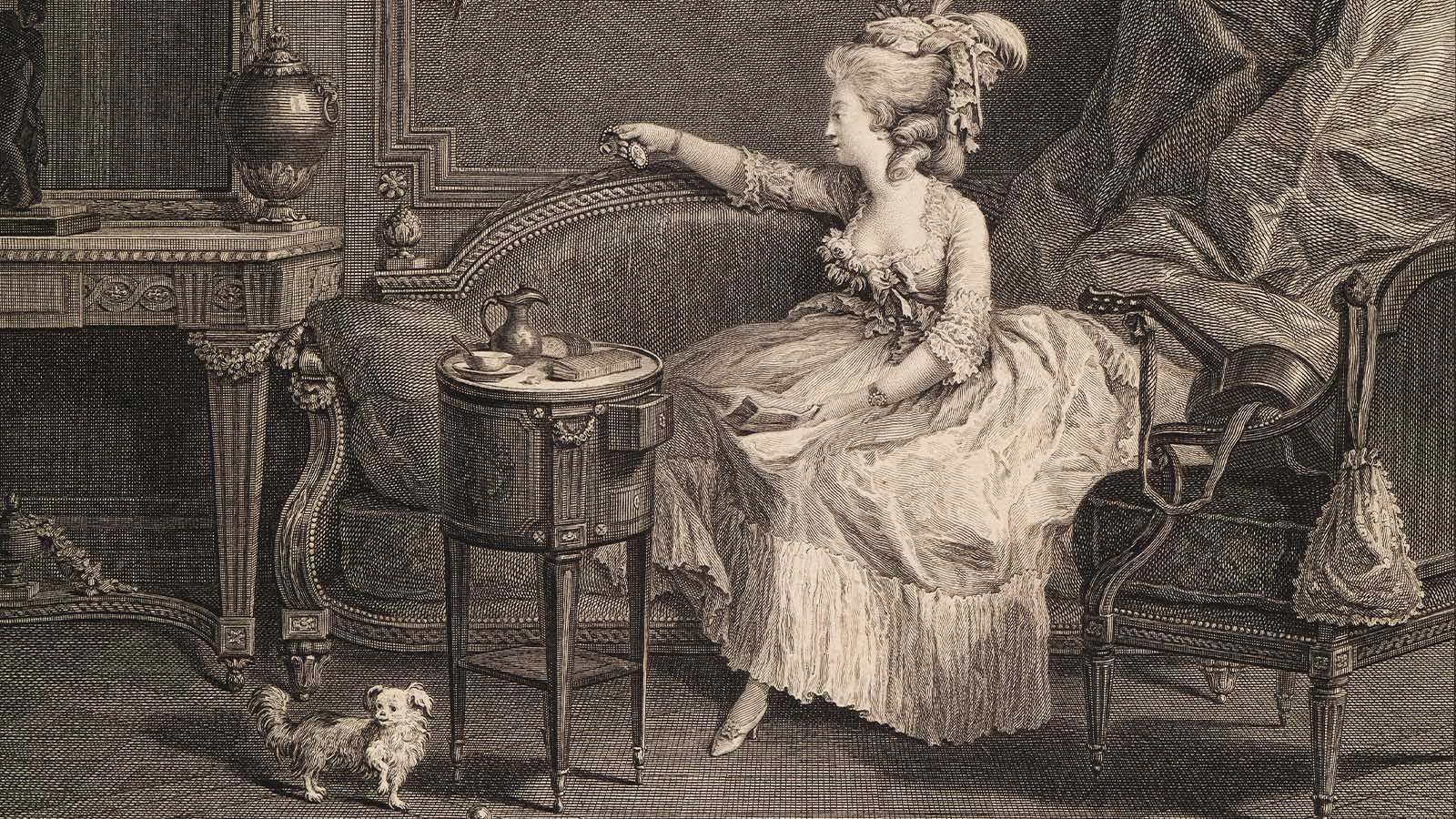Feast and intimacy
Moments at the table in 18th-century French prints and books
During his reign, Louis XV (1710-1774) continued the main royal dining practices of the French court, established or codified by his predecessor Louis XIV (1638-1715) to consolidate his image as an absolutist monarch. The most ceremonial of these occasions, the royal feast, is depicted in the book of Louis XV’s consecration, which describes the different phases of the ceremony in which he became king (fig. 1).
At other festive occasions, for example the ball illustrated in the book celebrating the first marriage of his son, Louis Ferdinand (fig. 2), buffets were served, ‘with all the most refined foods, including fruit, ice creams, wines, liqueurs and all kinds of refreshments.’ These selections of cold foods and drinks, sweet or savoury, were presented on platters, baskets or other sumptuous pieces of silverware, carefully combined with decorative elements, such as flower garlands, and lit by sophisticated candelabras, candlesticks or chandeliers, all arranged on ostentatious pieces of furniture.
![‘Le Sacre de Louis XV, Roy de France et de Navarre dans l'Église de Reims, Le Dimanche XXV Octobre MDCCXXII’. Paris: s.n., [1731], illustrated with designs by Pierre Dulin and decorative borders by Pierre-Josse Perrot, etched by different engravers. Calouste Gulbenkian Museum.](https://cdn.gulbenkian.pt/wp-content/uploads/sites/5/2023/11/festa-intimidade-3-1.jpg)
![‘Fêtes publiques données par la Ville de Paris à l'occasion du Mariage de Monseigneur le Dauphin, les 23 et 26 février 1745’. Paris: [Chez François Blondel et la veuve Chéreau], [1751], illustrated with drawings according to designs attributed to Jean-François Blondel etched and hand-coloured in the workshop of Jacques-Philippe, le Bas (?). Calouste Gulbenkian Museum.](https://cdn.gulbenkian.pt/wp-content/uploads/sites/5/2023/11/festa-intimidade-4-1.jpg)
For everyday meals, however, Louis XV made some modifications: the king’s meals in public became less frequent, with the introduction of regular soupers (suppers) in his private chambers – until then only rarely admitted in court, for example on return from hunting. At these dinners, guests no longer had to attend the royal meal standing or perched on benches, and were instead invited to take part and to sit on chairs in the king’s presence, at tables that were often round or oval, which contributed to a convivial atmosphere.
This intimate atmosphere, which spread to other aristocratic residences and private offices of the French court and gave rise to the first ‘dining rooms,’ can be seen in the print (fig. 3) shown before the Le Souper score (fig. 4). Included in the book of songs that De Laborde, Louis XV’s court official, dedicated to the then princess Marie Antoinette, this musical composition is a declaration of love for a ‘young Sylvie,’ and emphasises the freedom provided by the cacophonous noise of dinner.
![Jean-Benjamin de Laborde, ‘Choix de Chansons mises en musique par M. de La Borde, Premier Valet-de-Chambre ordinaire du Roi, Gouverneur du Louvre. Ornées d'estampes par J.M. Moreau, dédiées à Madame la Dauphine’. À Paris: Chez de Lormel, Imprimeur de l'Académie Royale de Musique [4 volumes], 1773, tome II, illustrated with designs by Jean-Jacques François Le Barbier, ‘l'aîné’, etched by François-Denis Née and Louis-Joseph Masquelier. Calouste Gulbenkian Museum.](https://cdn.gulbenkian.pt/wp-content/uploads/sites/5/2023/11/festa-intimidade-5-2.jpg)
![Jean-Benjamin de Laborde, ‘Choix de Chansons mises en musique par M. de La Borde, Premier Valet-de-Chambre ordinaire du Roi, Gouverneur du Louvre. Ornées d'estampes par J.M. Moreau, dédiées à Madame la Dauphine’. À Paris: Chez de Lormel, Imprimeur de l'Académie Royale de Musique [4 volumes], 1773, tome II, illustrated with designs by Jean-Jacques François Le Barbier, ‘l'aîné’, etched by François-Denis Née and Louis-Joseph Masquelier. Calouste Gulbenkian Museum.](https://cdn.gulbenkian.pt/wp-content/uploads/sites/5/2023/11/festa-intimidade-6-2.jpg)
In a more intimate context, without no staff present, we can see that other meal settings contributed to the plots of gallant scenes that were popular in the rococo style in eighteenth-century French society. A single cup and saucer (or, possibly, a bowl with a plate) next to a milk jug, which we see in the print La Consolation de l’Absence [Consolation of Absence] (fig. 5) reinforces the solitude of the character, who interrupts the reading of a letter to gaze at the miniature portrait likely to be of an absent lover.
However, in the print La Crainte [Fear] (fig. 6), the two cups and saucers next to a chocolate pot seem to confirm that the semi-naked female figure portrayed has been caught in the middle of an illicit amorous encounter with someone, who, because of a third figure close by, has fled, as suggested by the fallen chair, the agitation of a small dog, and the tense and anxious posture of the young woman.


Special thanks to Géraldine Chopin for her research into this theme as part of her training as a curator at the Institut national du Patrimoine, in Paris, and to the researcher João Pedro Gomes (University of Coimbra).


